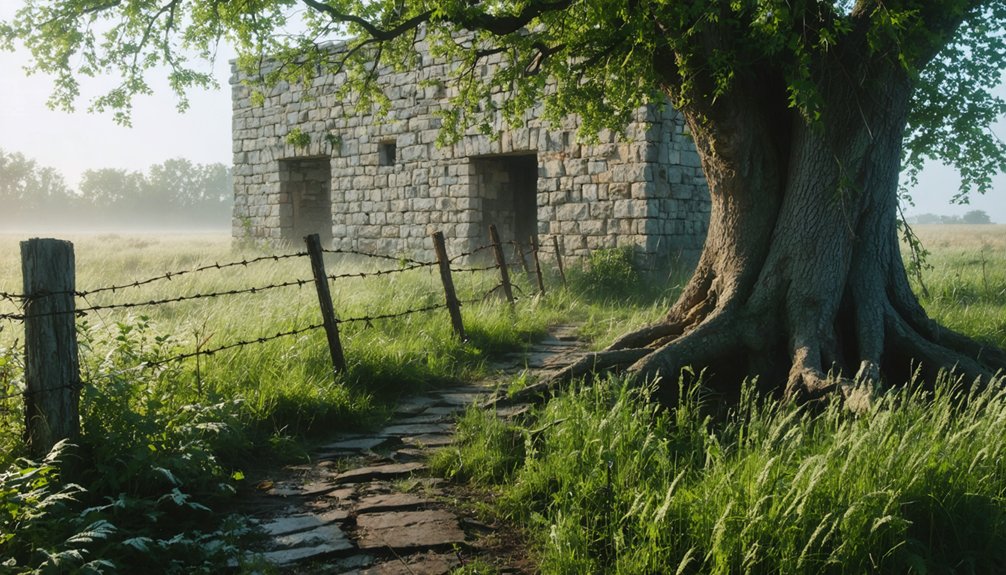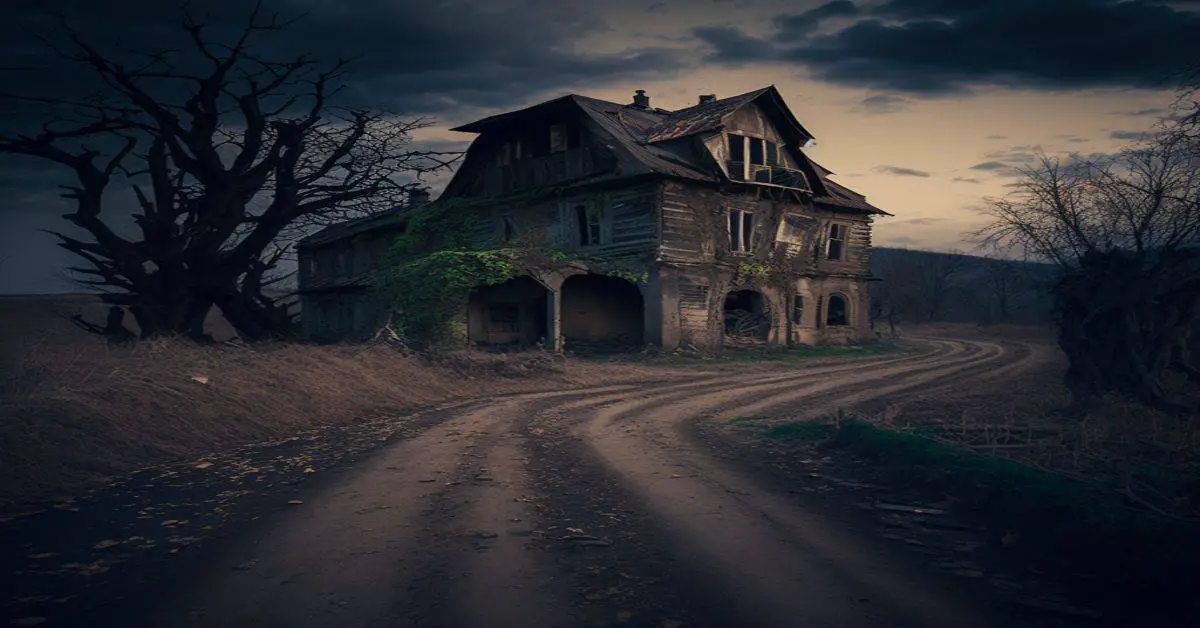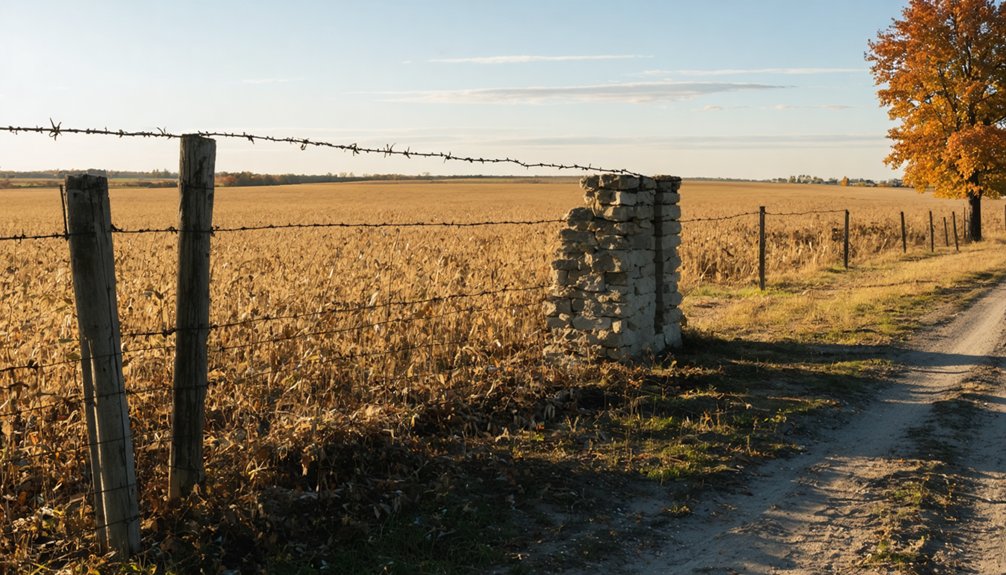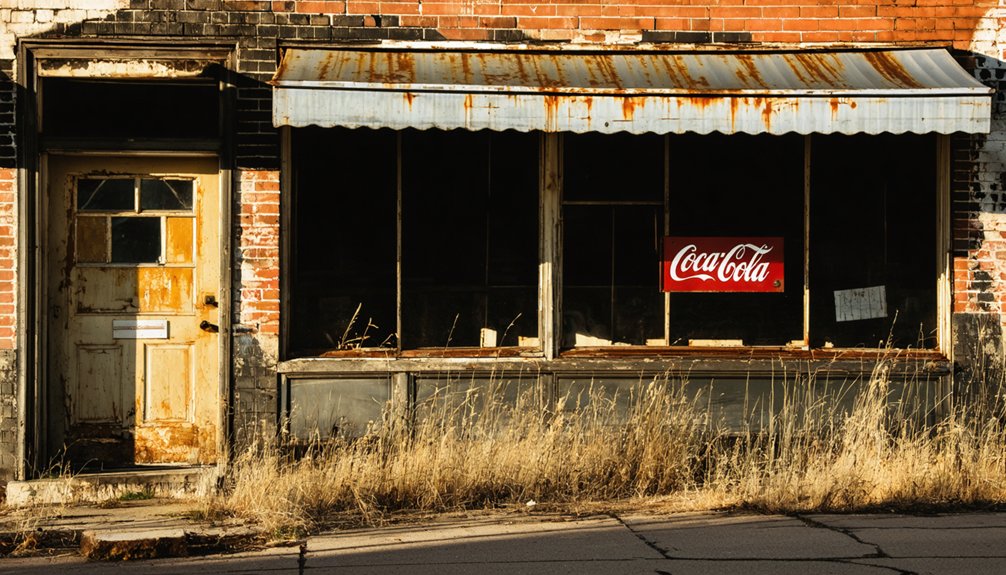You’ll find Bethel’s ghost town remains in Clay County’s Songer Township, where a once-bustling railroad settlement thrived in the mid-1800s. The town emerged along the Terre Haute and Alton railroad in 1854, established by Joel U. Starkey, and flourished as an agricultural hub with strong community ties. Today, only scattered foundations and a solitary church survive, drawing ghost hunters to its weathered grounds. The site’s rich history holds countless untold stories of early Illinois settlement life.
Key Takeaways
- Bethel was established in 1854 along the Terre Haute and Alton railroad in Clay County’s Songer Township, Illinois.
- The town flourished as a transportation hub and agricultural center before experiencing economic decline in the late 19th century.
- The 1925 Tri-State Tornado and Great Depression severely impacted the community, contributing to its eventual abandonment.
- Today, only scattered foundations, rusted metal, weathered bricks, and a single church remain at the ghost town site.
- The abandoned church attracts paranormal investigators and stands as the last significant structure in this former railroad settlement.
The Rise of a Railroad Settlement
As railroads expanded across Illinois in the mid-19th century, the small community of Bethel emerged along a significant rail line in Clay County’s Songer Township.
You’ll find that railroad expansion played an essential role in shaping this settlement, providing key connections to major urban centers like Chicago and Cairo through the Illinois Central Railroad’s network.
The Terre Haute and Alton was the railroad that defined the community’s early development after Joel U. Starkey laid out the town in 1854.
The first development was a small wooden shanty built by Thomas Smith, marking the beginning of construction in the area.
The strategic positioning of Bethel along the railway transformed it into a transportation hub, spurring initial community development through improved access to markets and trade opportunities.
Bethel’s railway location created a vital transport center, fostering growth by connecting local commerce to broader economic networks.
You’d have seen how the railroad’s presence drove the need for infrastructure, including stations and maintenance facilities.
This transportation backbone offered Bethel’s early settlers unprecedented mobility and economic possibilities, though the town would later face challenges that would ultimately lead to its decline.
Daily Life in 19th Century Bethel
Three distinct aspects defined daily life in 19th century Bethel: agriculture, community bonds, and pioneering resilience.
You’d find most residents working their fertile farmland, implementing traditional farming practices from sunup to sundown. Local merchants and craftsmen supported these agricultural pursuits, providing essential tools and services. The settlers came to the area seeking opportunities in the early 1800s. The town’s location along the railroad line made transportation and trade more accessible for residents.
Community gatherings served as the heartbeat of Bethel’s social life. You’d experience regular festivals, church services, and social events that brought families together, fostering strong relationships among neighbors.
The town’s schools and churches weren’t just institutions – they were crucial centers of connection and support.
Despite challenges like harsh weather, limited healthcare, and isolation, Bethel’s residents maintained their pioneering spirit. You’d witness their determination as they adapted to technological changes and economic pressures while preserving their close-knit community values.
Economic Shifts and Population Decline
While Bethel initially prospered as a thriving agricultural hub in the early 1800s, the town’s economic foundation began crumbling by the century’s end.
You’ll find that Bethel’s economic vulnerability stemmed from its heavy reliance on farming, which proved unsustainable as industrialization transformed the region.
The town’s challenges intensified when Southern Illinois’s coal mining industry faced labor unrest and eventual decline, destabilizing the broader regional economy.
Civilian Conservation Corps projects provided temporary employment but could not sustain the local workforce long-term.
Migration patterns tell a stark story of Bethel’s decline, as younger residents abandoned the town for urban industrial opportunities.
A once-vibrant farming community emptied as its youth traded rural life for factory jobs in distant cities.
Like nearby Ohio River settlements, many residents left seeking better prospects in larger industrial centers.
The 1925 Tri-State Tornado and Great Depression dealt additional blows to the struggling community.
With each passing decade, you’d see fewer occupied buildings and working farms, until Bethel’s transformation into a ghost town became complete.
What Remains Today
Today, you’ll find precious little evidence of Bethel’s once-vibrant community, with nature steadily reclaiming what humans left behind. Among the physical remnants, only scattered foundations peek through the vegetation, while bits of rusted metal and weathered bricks dot the landscape where streets and properties once stood.
Similar to the area around Fort Daniel Conservation Area, the land has been gradually returning to its natural state.
The solitary church stands as the most notable landmark amid the ruins, drawing occasional ghost hunters who’ve reported paranormal activity within its deteriorating walls.
Like nearby Pearl which has seen its population drop to 103 residents, Bethel exemplifies the dramatic decline of small Illinois towns.
You won’t find any preserved shops, schools, or civic buildings – they’ve all vanished into the Illinois countryside. The site lacks formal archaeological studies or tourist amenities, and it’s primarily visited by curious locals and historians.
Time and weather continue their steady erosion of Bethel’s last traces, as the ghost town slowly fades into the rural landscape.
Legacy in Clay County History
Despite its eventual abandonment, Bethel represents a quintessential chapter in Clay County‘s rural development story, emerging as part of the region’s early settlement wave in southern Illinois during the 1800s.
The area’s development accelerated after Indian removal in 1828, opening new opportunities for settlers to establish roots in the fertile region.
You’ll find its legacy woven into the fabric of Clay County’s agricultural traditions, where community connections once thrived around local commerce, church gatherings, and railroad activity.
While Bethel didn’t achieve the prominence of the county seat Louisville, established in 1842, it played an essential role in the area’s shift from frontier wilderness to settled farmland. The settlement pattern echoed ancient Bethel’s evolution from a small Canaanite village to a more established community.
Though no major historical figures or events are specifically tied to Bethel, its story mirrors countless other small communities that helped shape southern Illinois’s rural character during the pioneering era.
Frequently Asked Questions
Were There Any Churches or Schools Established in Bethel During Its Existence?
You won’t find documented church history or education legacy for this settlement, as available records don’t confirm any established churches or schools during Bethel’s brief existence in Clay County.
What Was the Closest Major Town or City to Bethel?
Like a lonely star in the night, Greendale was your closest populated settlement, though historical landmarks indicate it too was small. Effingham, about 35-40 miles northwest, was the nearest major city.
Did Any Notable Historical Figures Ever Visit or Live in Bethel?
You won’t find any famous visitors or notable historical figures in Bethel’s records. The town’s historical significance stemmed from everyday pioneers and farmers rather than prominent individuals who visited.
What Happened to the Property Deeds After the Town Was Abandoned?
You’ll find the property transfers and deed history maintained at Bond County’s Recorder’s office, where they’ve preserved all records since 1817, including ownership changes during abandonment, foreclosures, and tax forfeitures.
Were There Any Newspapers or Publications Produced in Bethel?
You won’t find any trace of Bethel publications or journalism – not a single newspaper was ever produced there. The town was too small and short-lived to support its own media outlet.
References
- https://illinoisstateonline.com/ghost-towns-in-illinois/
- https://michaelkleen.com/2021/08/24/the-legend-of-bethel-ragdoll-cemetery/
- https://www.youtube.com/watch?v=H9TqIIgseiw
- https://pikelincoln.com/explore-historical-pike-county/eastern-district/bethel-church-cemetery/
- https://drloihjournal.blogspot.com/p/lost-towns-of-illinois-series.html
- https://en.wikipedia.org/wiki/Bethel
- https://drloihjournal.blogspot.com/2022/09/lost-towns-of-illinois-bethel-illinois.html
- https://en.wikipedia.org/wiki/List_of_ghost_towns_in_Illinois
- https://en.wikipedia.org/wiki/Bethalto
- https://madison.illinoisgenweb.org/town_histories/bethalto_history.html



